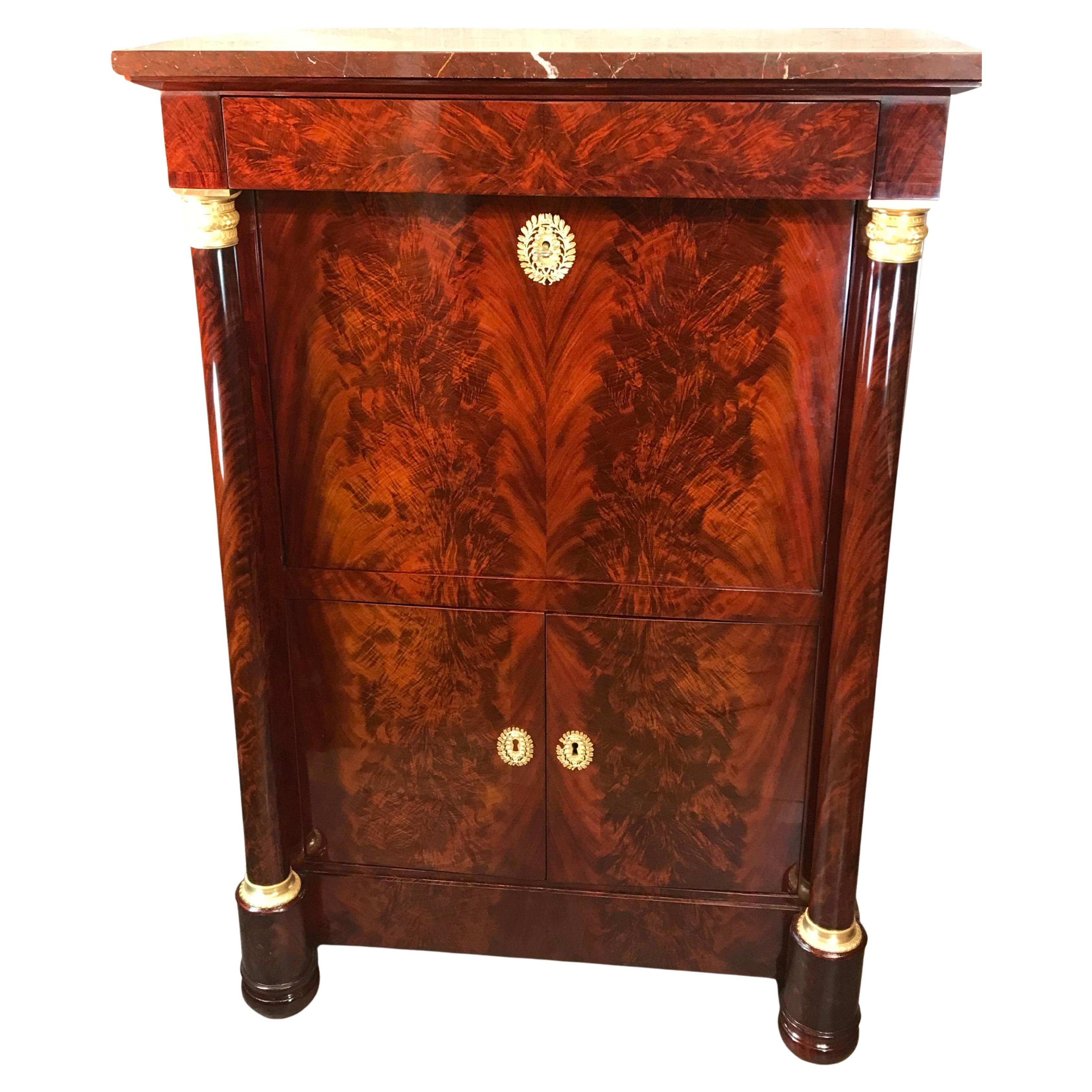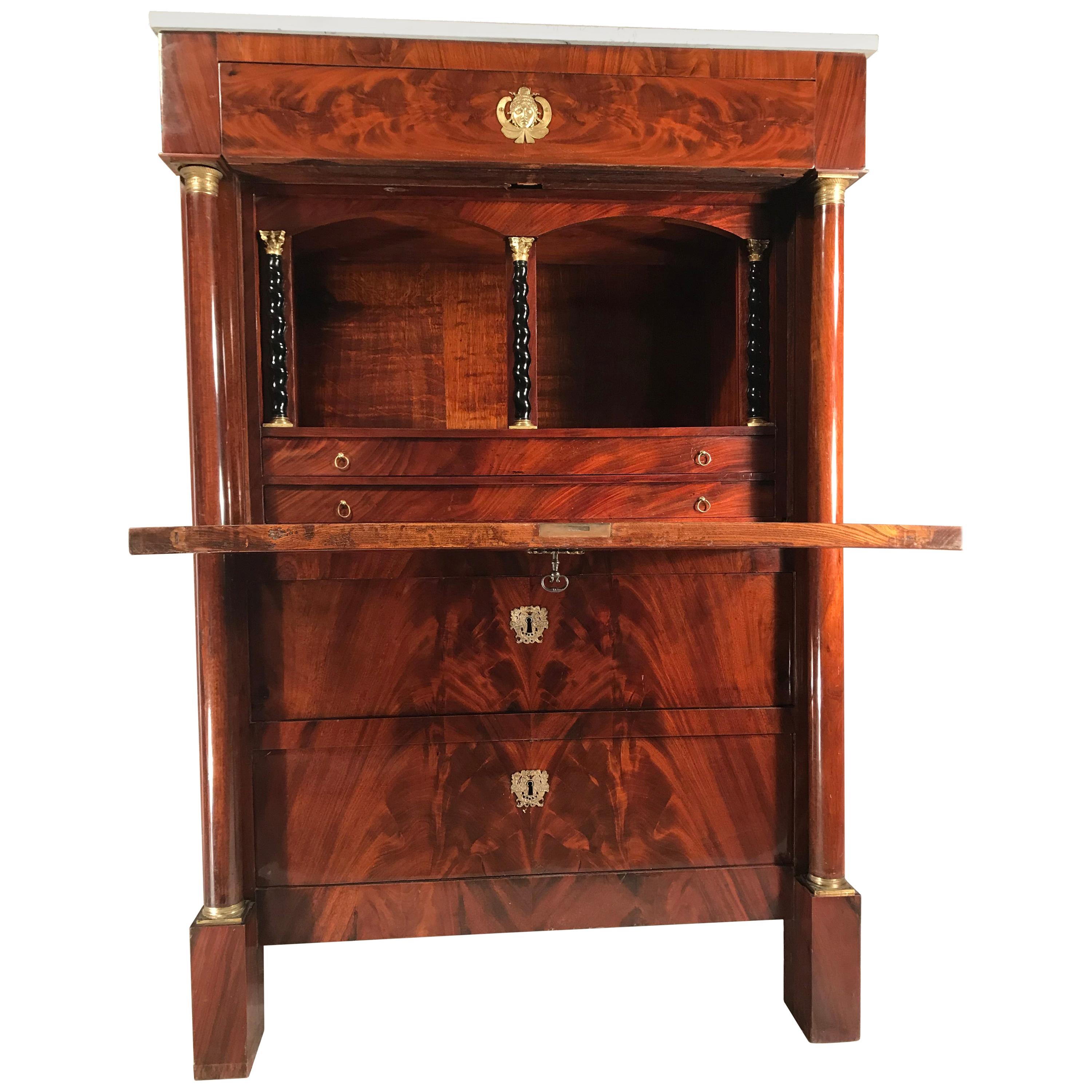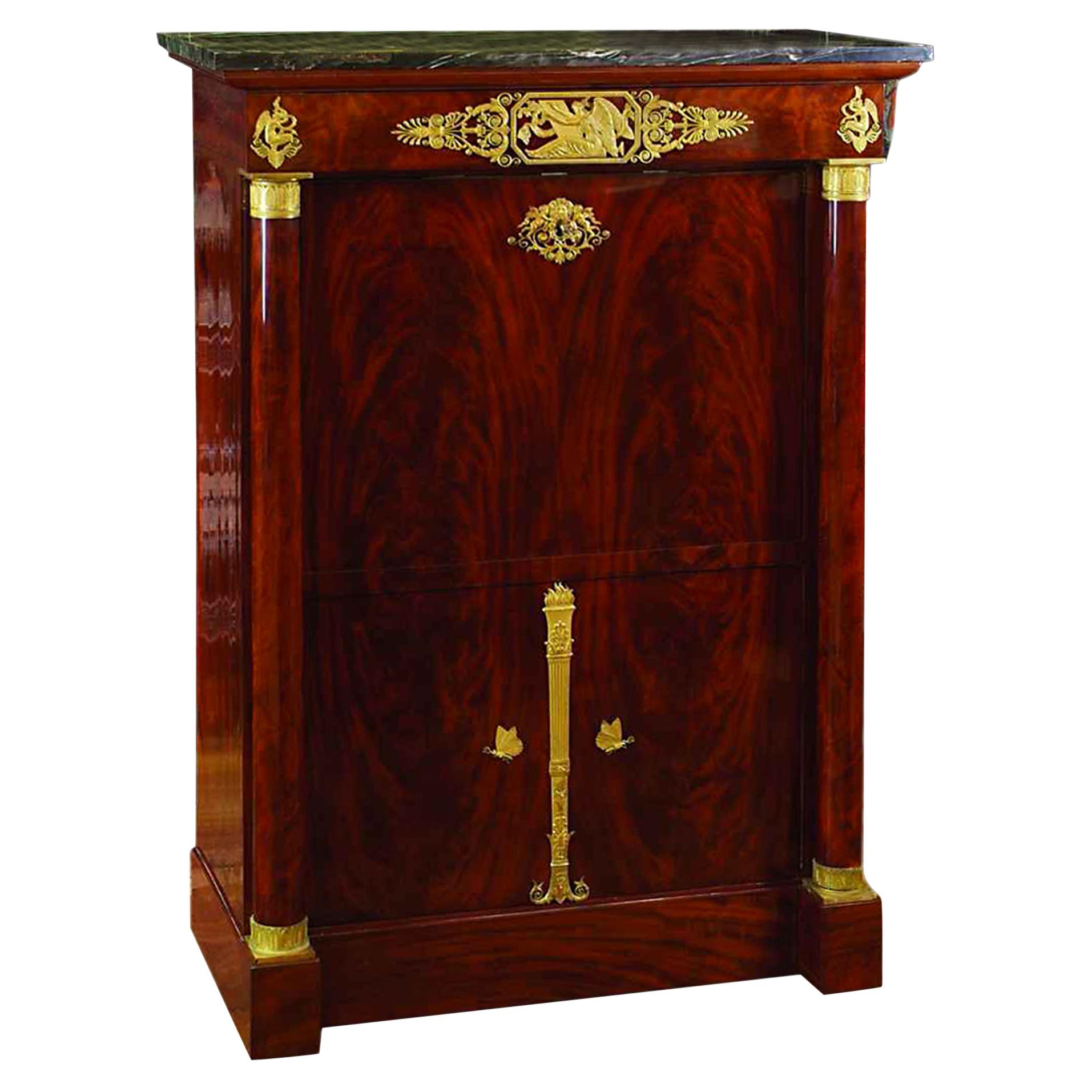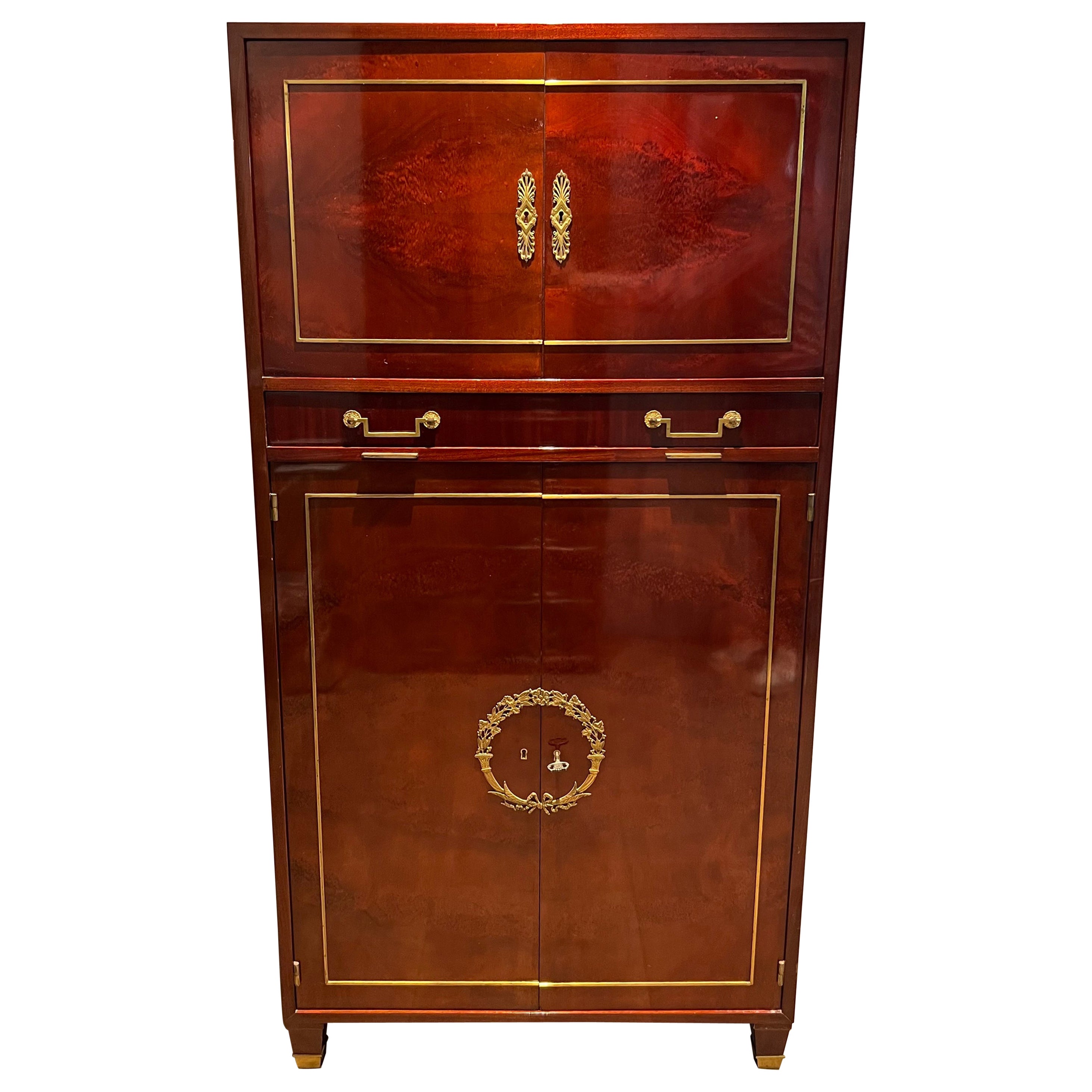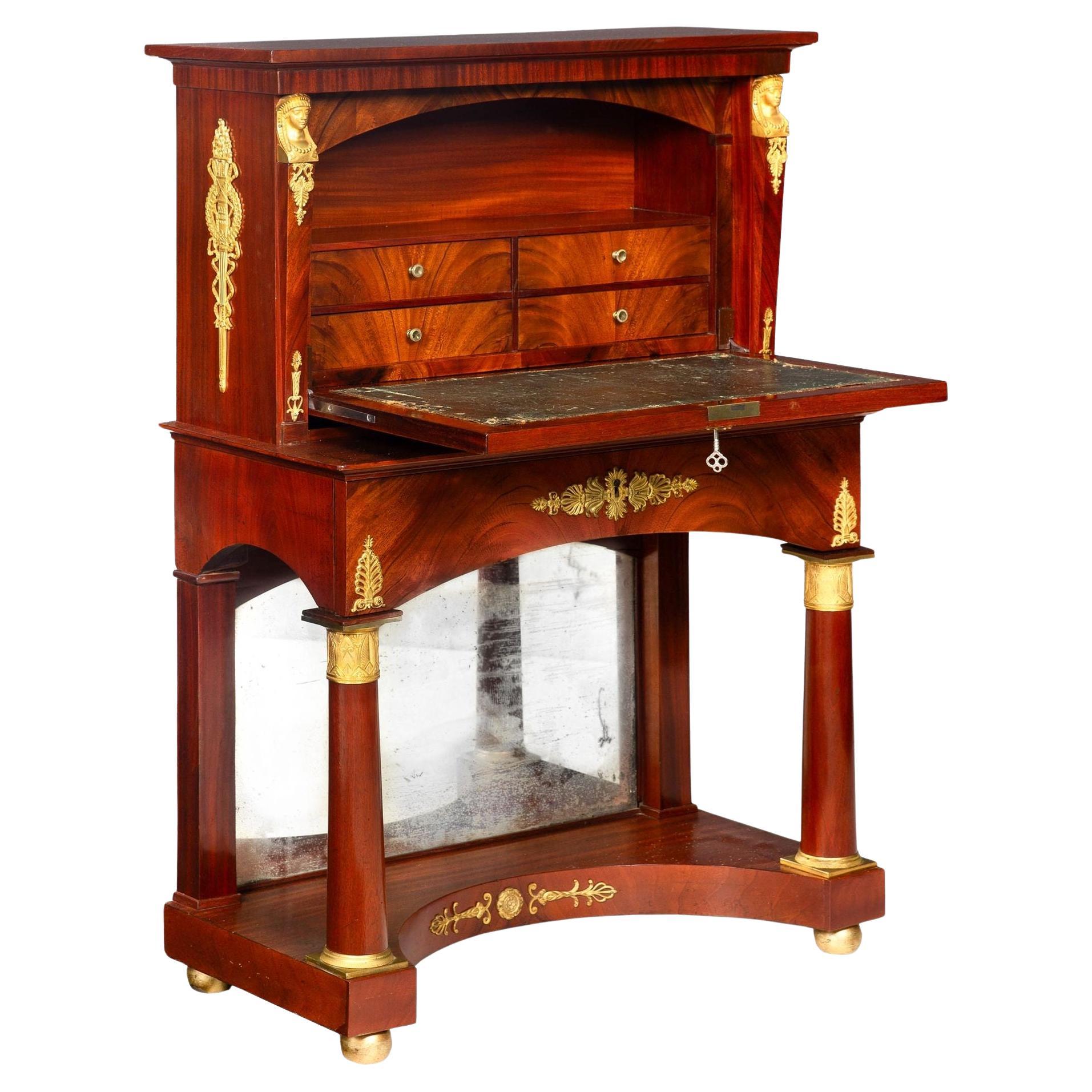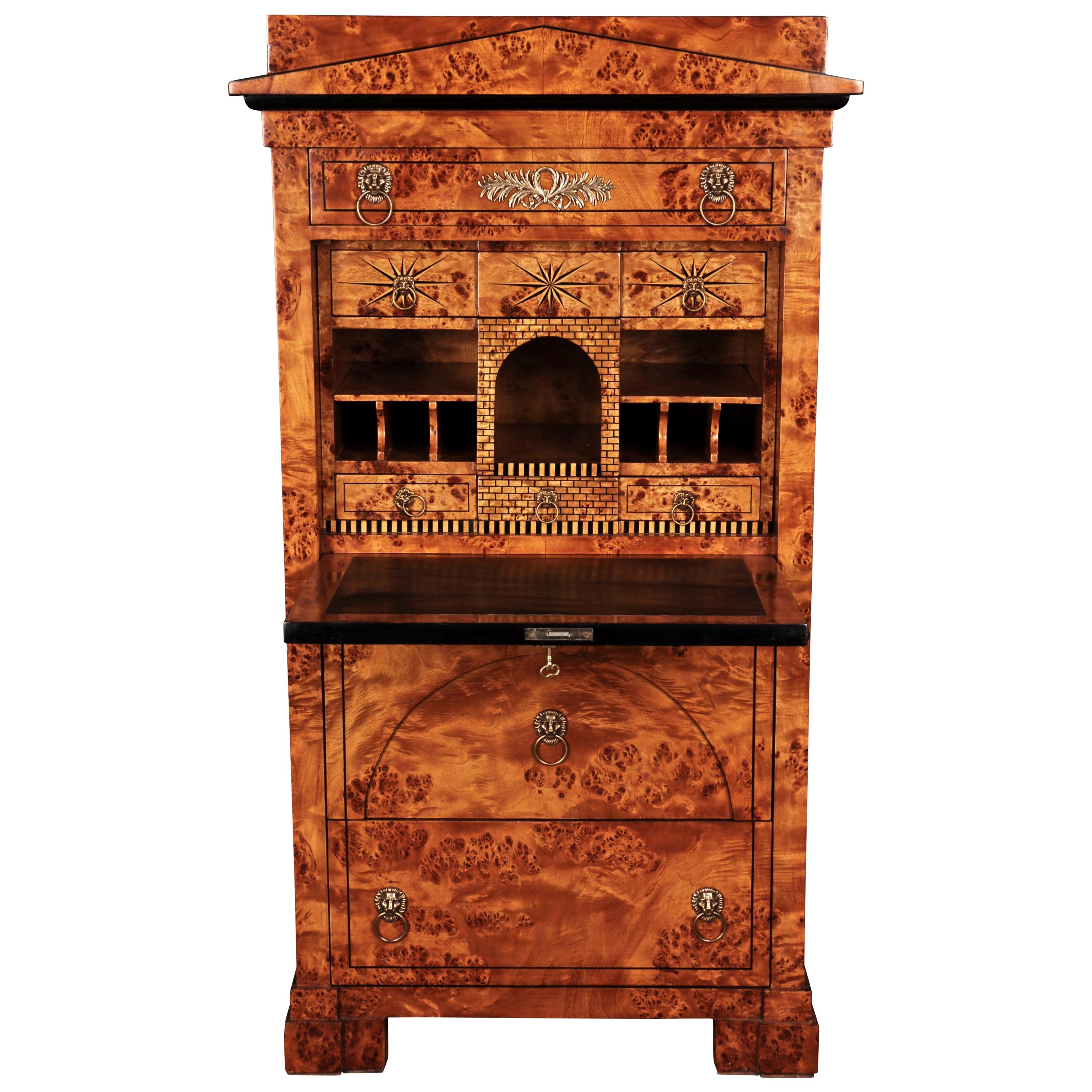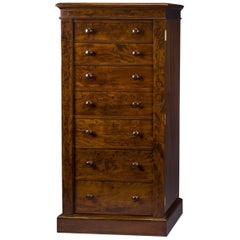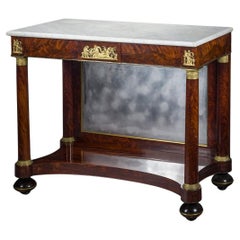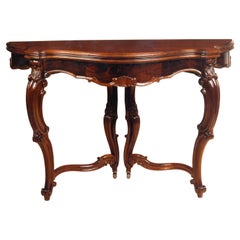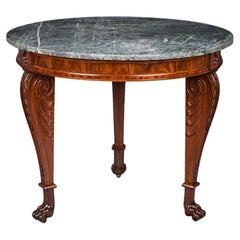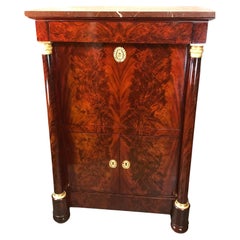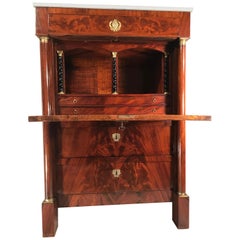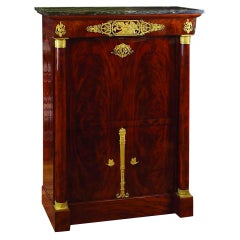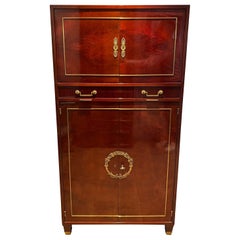Items Similar to Butler's Desk and Etagére, New York, Possibly Duncan Phyfe
Want more images or videos?
Request additional images or videos from the seller
1 of 6
Butler's Desk and Etagére, New York, Possibly Duncan Phyfe
$75,000
£56,974.75
€65,606.09
CA$107,295.08
A$117,692.34
CHF 60,689.52
MX$1,405,718.10
NOK 769,727.70
SEK 722,091.92
DKK 490,273.20
About the Item
Butler’s Desk and Etagére, circa 1825
New York, possibly by Duncan Phyfe
Mahogany (secondary woods: mahogany, pine, poplar), with ormolu mounts, marble, and brass
54 in. high, 36 5/8 in. wide, 23 5/8 in. deep
EX. COLL.: Buffalo, New York, collection, and by descent, until 2016
Certain standard furniture forms, such as center tables, secrétaries á abattants, klismos chairs, work tables, center tables, and so forth, dominated the production of the leading American cabinetmaking shops during the Neo-Classical period, but other less usual forms were also produced, often likely on special order.
The present butler’s desk is one of those pieces, as the exact form does not seem to have previously appeared. Above the cupboard doors below is what, from the outside, appears to be a long drawer, but the front actually pulls down to form a baize-lined writing surface, with cubbyholes behind. Above the lowest of the three marble surfaces is a pair of doors revealing a storage cabinet presumably for miscellaneous household papers. Another related piece is a small sideboard that was included in the Duncan Phyfe exhibition at The Metropolitan Museum of Art, and the Museum of Fine Arts, Houston, in 2011–12 (see Peter M. Kenny, Michael K. Brown, Frances F. Bretter, and Matthew A. Thurlow, Duncan Phyfe: Master Cabinetmaker in New York, exhib. cat. [New York: The Metropolitan Museum of Art, 2011], pp. 270–71 plate 67).
Although the form of the piece is unusual in the context of American production, it does find precedent among English Regency designs, which are also echoed in a Boston étagère in a New York collection (see Stuart P. Feld, Boston in the Age of Neo-Classicism, 1810–1840, exhib. cat. [New York: Hirschl & Adler Galleries, 1999], p. 50 no. 16 illus.). But whereas the maker of the Boston piece looked to English sources for the detailing of his piece, the present piece is a blend of English Regency and French Empire design, the ormolu capitals and bases in two sizes likely being a French import.
Although the outstanding quality of this piece would suggest an attribution to the distinguished shop of Duncan Phyfe, his style became so popular among his contemporaries that it is difficult to assign the work to him without some form of documentation.
Condition: Excellent. The baize surface on the desk has probably been replaced. Cleaned and French polished.
- Attributed to:Duncan Phyfe (Cabinetmaker)
- Dimensions:Height: 54 in (137.16 cm)Width: 36.63 in (93.05 cm)Depth: 23.63 in (60.03 cm)
- Style:Neoclassical (Of the Period)
- Materials and Techniques:
- Place of Origin:
- Period:
- Date of Manufacture:circa 1825
- Condition:Replacements made. Wear consistent with age and use. CONDITION: Excellent. The baize surface on the desk has probably been replaced. Cleaned and French polished. This piece has been vetted by the Winter Antiques Show vetting committee as described in this listing.
- Seller Location:New York, NY
- Reference Number:Seller: FAPG 20873D/21stDibs: LU90327942253
About the Seller
No Reviews Yet
Recognized Seller
These prestigious sellers are industry leaders and represent the highest echelon for item quality and design.
Established in 1952
1stDibs seller since 2010
Associations
Art Dealers Association of America
- ShippingRetrieving quote...Shipping from: New York, NY
- Return Policy
Authenticity Guarantee
In the unlikely event there’s an issue with an item’s authenticity, contact us within 1 year for a full refund. DetailsMoney-Back Guarantee
If your item is not as described, is damaged in transit, or does not arrive, contact us within 7 days for a full refund. Details24-Hour Cancellation
You have a 24-hour grace period in which to reconsider your purchase, with no questions asked.Vetted Professional Sellers
Our world-class sellers must adhere to strict standards for service and quality, maintaining the integrity of our listings.Price-Match Guarantee
If you find that a seller listed the same item for a lower price elsewhere, we’ll match it.Trusted Global Delivery
Our best-in-class carrier network provides specialized shipping options worldwide, including custom delivery.More From This Seller
View AllSeven-Drawer Tall Chest of Drawers
Located in New York, NY
Boston, Massachusetts
Seven-drawer tall chest, circa 1825.
Mahogany (secondary woods: mahogany, pine, and poplar)
Measures: 45 5/8 in. high, 27 5/8 in. wide, 14 5/8 in. deep
Inscribed (on six drawer locks): SECURE; (on seventh lock): CHUBB’S / PATENT / 57 St PAULS CHY / LONDON / CHUBB & SON / MAKERS TO / HER MAJESTY / 632284; (on one hinge): [BUR?] NE PATENT; (on master lock): 2 LEVER.
Although some Boston furniture of the Neo-Classical period is elaborately decorated with ormolu mounts, brass moldings, and carved and gilded elements, other pieces are more simple and are said to reflect the “conservative” taste of many of Boston’s great families. The simplicity evident in these pieces is not an indication of a less-expensive line of furniture or a less-sophisticated patronage, but, like the so-called “Grecian Plain Style” of Duncan Phyfe’s furniture...
Category
Antique 1820s American Neoclassical Commodes and Chests of Drawers
Materials
Mahogany
Pier Table
Located in New York, NY
One of the signature forms of the Neo-Classical period, the pier (or console) table received its name from its typical use against the wall, or pier, between two windows. Pier tables...
Category
Antique 1810s American Neoclassical Tables
Materials
Marble, Brass, Bronze, Lead
$65,000
Card Table in the Rococo Taste
By Charles A. Baudoine
Located in New York, NY
RECORDED: cf. Anna Tobin D’Ambrosio, ed., Masterpieces of American Furniture from the Munson-Williams-Proctor Institute (Syracuse University Press, Utica, New York, 1999), pp. 85, 86, 87 illus. the Munson-Williams-Proctor tables // cf. The Metropolitan Museum of Art, New York, 19th Century America–Furniture and Other Decorative Arts (1970), exhib. cat., [n.p.] no.133
This table is identical to a pair of card tables bearing the stenciled label of Charles A. Baudouine of 335 Broadway, New York, which were acquired by James and Helen Munson Williams of Utica, New York, in May 1852 for their home, Fountain Elms, which is where they remain today as part of the Munson-Williams-Proctor Art Institute collection. The Williams tables were billed as “1 Rosewood Multiform Table” at $160 for the pair, and they were indeed “multiform” in that they could be used separately and folded as a pair of console tables, opened as a pair of card tables, or joined together as a center table. The present table varies essentially in the fact that it does not include the mechanism that would have allowed it to be attached to another to form a center table.
Of French descent, Baudouine was born in New York in 1808. He made his debut as a cabinetmaker in the New York directory of 1829/30, where he is listed at 508 Pearl Street. By 1839/40 he relocated to Broadway, where he remained in business at various addresses until about 1854. A sense of the scale of Baudouine’s operation is given by German immigrant cabinetmaker Ernest Hagen...
Category
Antique Mid-19th Century North American Rococo Revival Card Tables and T...
Materials
Wood, Rosewood
Center Table with Scroll Legs, Paw Feet and Marble Tops
By Thomas Seymour
Located in New York, NY
Center Table, about 1818–20
Attributed to Thomas Seymour (1771–1848), working either for James Barker or for Isaac Vose & Son, with Thomas Wightman (1759...
Category
Antique 1810s American American Classical Center Tables
Materials
Wood, Mahogany
Fan-Carved Wood Mantel in the Federal Taste
Located in New York, NY
New York,
Fan-carved mantel in the Federal taste, circa 1812
Pine
Measures: 66 1/4 in. high, 90 3/8 in. wide, 13 1/4 in. deep
Within the genre of carved rather than plasterwork mantels of the Federal Period, no example that has come to light is more perfectly designed or more carefully wrought than the present one, which is an amazing symphony of fans, urns, beads, and other Neo-Classical devices, all ultimately influenced by the plasterwork designs of the English architects Robert (1728–1792) and James (1732–1794) Adam.
Of a type that proliferated in the area bounded by the northern New Jersey counties of Bergen and Passaic, the Hudson Valley, and western Long Island, the mantel is representative of work that flourished in the first couple of decades of the 19th century. While most of the woodwork of this style that has survived is found in interiors, various examples of exterior doors and other trim have been noted, but most examples have disappeared as a result, variously, of natural deterioration and purposeful demolition in anticipation of development.
Although considerably larger in scale and more elaborate in ornament than a mantel that has been in the collection of the Brooklyn Museum since 1944 (acc. no. 44.55; photograph in Hirschl & Adler archives), the present mantel is so close in style and conception to that example that it likely originated in the same house.
The Brooklyn mantel is documented as having been removed from a house built by Judge Isaac Terhune (1762–1837), an eminent lawyer and judge. The house was situated on King’s Highway, at the corner of Mansfield Place, at the edge of South Greenfield, a village in northern Gravesend, Brooklyn. A photograph of the house, taken by the German e´migre´ photographer, Eugene Armbruster (1865–1933), is in the collection of the New-York Historical Society.
Terhune is ultimately descended from the Dutch-Huguenot e´migre´ Albert Albertson Terhunen, who died in Flatlands, Brooklyn, in 1685.The family eventually spread out through New Amsterdam, Long Island, and Bergen County, New Jersey. Terhune’s great-grandson, also Albert (1715–1806), left a sizable estate to his six surviving children, including his second child and second son, Isaac.
Judge Terhune lived in the house until his death in 1837, at which time, according to an article in The New York Times for November 27, 1910, he, having died without issue, “left the White Frame Mansion with its exquisitely carved doorway, beautiful mantels, and other interior adornments to his brother John” (Part Six, p. 11).
The article continues:
After the latter’s death, the house and its estate of about 70 acres passed through several owners, eventually being purchased in 1853 by Benjamin G. Hitchings [1813–1893].
The house next passed to Benjamin’s son, Hector, who had been born in the house, and then lived there for 25 years. He sold it in 1910 in partial payment for a Manhattan apartment house. After thus having been sold to a real estate developer, the Hitchings property was subdivided into Hitchings Homestead. The house survived until about 1928, at which time it was razed and a Deco-style apartment house with the address 2301 Kings Highway was constructed on the site and occupied in 1935.
By 1910, the fate of the house, in an area of Brooklyn that was being rapidly developed, was becoming obvious. The Times article reported:
The house has been well kept up, but fearing lest the hand of time or vandals might deal harshly with some of its choice bits of carving, Mr. Hitchings removed a few years ago a few beautifully carved wood mantels...
Category
Antique 1810s American Neoclassical Fireplaces and Mantels
Materials
Wood
Miniature Striped-Maple Serpentine Chest of Drawers
Located in New York, NY
American, probably Boston or Salem, Massachusetts
Miniature Serpentine Chest of Drawers, circa 1785-1800
Striped maple, ebony, and rosewood (secondary woods: mahogany), with brass dr...
Category
Antique 1780s American Chippendale Commodes and Chests of Drawers
Materials
Wood
You May Also Like
Empire Secretary Desk, France 19th century
Located in Belmont, MA
French Empire Secretary Desk, 19th Century – Mahogany Veneer, Marble Top, Bronze Details
This stunning 19th-century French Empire secretary desk...
Category
Antique 1810s French Empire Secretaires
Materials
Marble
Empire Fall Top Desk, France, 1810
Located in Belmont, MA
Introducing a remarkable Empire Fall Top Desk, hailing from France during the period of 1800-1810. Crafted with meticulous attention to detail, this magn...
Category
Antique Early 1800s European Empire Secretaires
Materials
Mahogany
French First Empire Period, circa 1805, ‘Secretaire Abattant’
Located in West Palm Beach, FL
A most powerful and of the highest quality French First Empire period, Circa. 1805, "Secretaire Abattant'. The secretary is solid Cuban mahogany and fire gilded ormolu mounts with tw...
Category
Antique 19th Century French Desks
Materials
Ormolu
Empire style secretary desk in flamed mahogany in the style of Aldo Tura work
By Aldo Tura
Located in Marcq-en-Barœul, Hauts-de-France
Empire style secretary desk in flamed mahogany and bronze locks. This is an Italian work in the style of Aldo Tura. Circa 1970
Category
Vintage 1970s Italian Neoclassical Secretaires
Materials
Bronze
French Empire Style Mahogany Antique Secretary Desk
Located in Shippensburg, PA
EMPIRE STYLE GILT-BRONZE MOUNTED MAHOGANY SECRETARY DESK
Composed of 19th century elements
ref. 501GWU22P
45 7/8" H x 32 1/8" W x 15 5/8" D; writing area is 15" D x 26 1/8" W
Thi...
Category
20th Century French Empire Desks
Materials
Bronze, Ormolu
20th Century Biedermeier Style Secretaire
Located in Berlin, DE
Delicate secretaire in Biedermeier style.
Maple roots on solid pinewood. Natrual leather covered and gold-embossing.
(L-Mhs-42).
Category
20th Century Biedermeier Secretaires
Materials
Leather, Wood, Maple
More Ways To Browse
Antique Butler
Butler Antique Furniture
Used Duncan Furniture
French Writing Desk With Chair
Mahogany Etagere
Duncan Phyfe
Antique Mahogany Etagere
Duncan Antique Furniture
Duncan Phyfe Furniture
Butlers Cabinet
Antique Klismos Chair
Duncan Phyfe Style
Antique Duncan Phyfe
Antique Butler Cabinet
New York Mahogany
Duncan And Phyfe
Ormolu Mount French Empire Chair
Duncan Phyfe Antique Furniture
